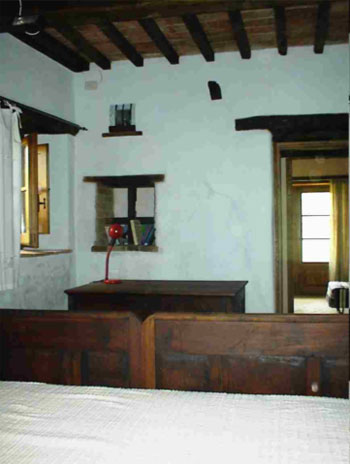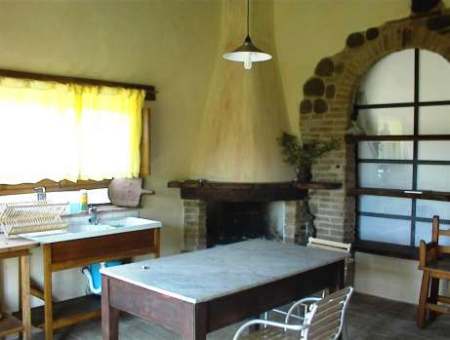Cimbolello
A family-run organic farm and agritourism of 5 hectares located two kilometres from the medieval village of Città della Pieve, with a stone farmhouse restored using completely organic materials and means. You’ll find us in Umbria, 12 km from Chiusi (Chiusi-Chianciano autostrada exit and central train station), 15 km from Trasimeno lake, 40 km from Orvieto and Perugia, 70 km from Siena, 130 km from Rome and Florence.
We are located at an altitude of 480
metres. Facing nearby Tuscany, the farm is composed of a vineyard,
olive grove, field for several sheep, household pets, bees, and a
nearby forest facing which is our house and agritourism apartments
(completely self-sufficient) which we offer year round. The farm
produces wine, oil, honey, cheeses, and many other products which you
will find described in this page.
Agritourism
The agritourism is composed of two pleasant apartments (kitchen, bedroom, bathroom). The first comfortably accommodates two people with a third on a pullout bed. The second comfortably accommodates four with two more on a sofabed in the kitchen. Heating is not included in the room rate. The apartments have a small yard which finishes in a quaint wood, and the view over Tuscany melts into a thousand colours.
Our simple rural life offers the opportunity to enter a world and a lifestyle that today is nearly forgotten, and that never ceases to please us. Indeed, we’ve held these aims of simplicity and self-sufficiency for more than 25 years. The importance of raising animals, the pride in such an endeavour, the pruning, fertilizing, harvesting, and essentially transforming of our vegetable and animal products provide us with varied and continuous work, interests, stimuli, and opportunities to learn. Our animal products include cheese, yoghurt, and ricotta all coming from sheep’s milk; honey, propoli, wax, and pollen from our bees; and eggs from our hens. Our vegetal products are more diverse, the most important being olive oil, of which we produce around 300 litres with only slightly more than a hectare grove (we have participated in three competitions, winning two for quality of oil); and wine (from the vineyard we also produce grape juice). We vinify ourselves and, beyond our personal consumption, sell around 800 bottles of wine, including both red and white, annually. Our own vineyard extends approximately 6,000 square metres, in addition to which we manage the 3,000 square metre vineyard of our neighbour, who in return allows us use of his tractor.
We have a forest which provides us with wood – unfortunately never enough – for home heating. There is also the vegetable garden, a fruit grove, medicinal lavender plants from which we extract the essential oils to make soap, and starting this year we raise saffron plants as well. The yields of our various crops vary widely, of course, and depend in large part on the climatic conditions of a given year.
We are not a business, nor do we hope to become one; we simply produce, transform, and either sell directly or exchange our products.
The care of the land and the animals is carried out above all within the scope of maintaining an organic farm and lifestyle, and only when possible for the production of natural or homeopathic goods.
We work constantly with the thought of leaving the world better than when we arrived, and the satisfaction of living sensibly and peacefully with animals informs our decision to be vegetarians, albeit with respect for those who have not made such a choice.
Our farm-life is open to all; we belong to the international organization WWOOF, through which individuals interested in alternative rural experiences can come spend time with us, working and living as a part of our family.
The wilderness in which we have chosen to set ourselves provides us with constant gifts, from chestnuts to mushrooms to herbs to wild berries….certainly enough to live on.
In our home we have a workroom in which we bottle preserves and undertake various other jobs, a carpentry workshop (my former vocation, about which I have been passionate for over 25 years), a wine cellar, and a wood oven in which we make pizza and bake bread. In the near future we plan to add a small workroom to house our potter’s wheel so that we can craft clay as well.
Clearly, the aforementioned laboratories constitute an integral part of our daily activities; beyond building and adjusting as needed, we have planned and constructed a fruit and vegetable dryer which operates primarily via a solar panel, and by way of electricity when solar energy is lacking.
We are very interested in self-production, and participate in product exchanges (never intended for sale) with other farmers, exchanges which are informed in large part by our needs as dictated by the environment and its climate and cycles.
In addition to exchanging products, we operate occasionally by way of work exchange, in which one applies his or her skills in the service of another, and in return receives the specialized help of that person.
We believe that a better way of life is possible in the direction of self-sufficiency, but even we have to go to the supermarket now and again.
Nevertheless we manage to harvest much more than we need to survive, and this is a satisfying accomplishment indeed.
The Context
In these few lines I’d like to linger for a moment in the nearby surroundings of our home. Umbria and Tuscany at large won’t be discussed; for this there exist volumes upon volumes already. There are tremendous things and people within the range of only a few kilometres. Friends that live and produce on a farm removed from unhealthy living, friends that for the last twenty years have chosen Umbria as their home and their life together, coming from Germany with stories, histories, and a fervent desire to live on this land. We gladly pass on these precious contacts to individuals in search of artisanal products – both crafts and foods – a ride on horseback (also available to disabled individuals), or a course in craftsmanship. I myself have a completely functioning workshop and am glad to provide lessons on carpentry and repair work. The nearby thermal baths of San Casciano dei Bagni offer entrance to a world apart. Magnificent. Immersed in a spectacularly verdant area, free both in spirit and payment. Going their on a cold winter’s night, immerging yourself in the 39 degree waters, is a regenerating, communal, and invigorating experience. Etruscans and Romans keep you company.. The Devil’s Dens, natural grottoes dating back to prehistoric times, only now accessible thanks to a local cooperative which also manages a modest but interesting museum, and offers its knowledge in guiding small groups through the Dens. There are two courses, one for families, another more demanding which includes sections of rope and hook work. In short, there is always something to do in the area, be it under the heading of nature, gastronomy, history, modern or ancient art. There are concerts, theatres….
Prices of the apartments
| Leccio Apartment's pricing (2 + 1 persons) (pricing for the whole apartment for one night) |
|
|---|---|
|
High
Season (Easter-Christmas-New Year-July-August)
|
65,00
€
|
|
Low
Season
|
50,00
€
|
|
Weekend
(low season only) |
140,00
€ (two nights)
|
|
Just One night
(low season only) |
80,00
€
|
| Heating |
Consume-based
|
|
Apartment
given clean, complete of linings and towels
 |
|
| Uvafragola Apartment's pricing (4+2 persons)
(pricing for the whole apartment for one night) |
|
|---|---|
|
High
Season (Easter-Christmas-New Year-July-August)
|
85,00
€
|
|
Low
Season
|
70,00
€
|
|
Weekend
(low season only) |
170,00
€ (two nights)
|
|
Just One night
(low season only) |
95,00
€
|
|
More
than 4 persons
|
15,00
€ each
|
| Heating |
Consume-based
|
|
Apartment
given clean, complete of linings and towels
 |
|
E-mail: podere@cimbolello.it
Phone: +39 0578 298181
Mobile: +39 340 2233389
2
people
apartment photos - and - 4
people
apartment photos
map of
place and address - ... - map of the web
site in italian